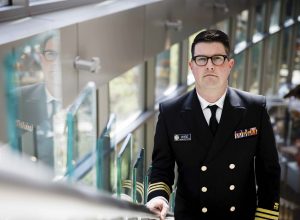
Photos by Dustin Chambers
ON A SWELTERING Monday afternoon last September, a few minutes before 3 o’clock, Matthew Wise ’01 hustled down the hall from his office to a windowless conference room at Atlanta’s Centers for Disease Control and Prevention (CDC) headquarters. Nearly three dozen scientists had crammed in there for the weekly meeting. At the head of the table, Wise slid into his swiveling chair, trying his best not to wrinkle his neatly pressed commander’s uniform.
His team of epidemiologists soon fired off one-minute updates of roughly 30 different food-borne illness outbreaks. He stared at a giant flat-screen filled with bar charts, hoping to triage minor threats from the major ones. Cyclospora outbreak caused by vegetable trays? Fully contained. Listeria linked to deli ham? Under control. Then came the details of a cluster that demanded his full attention: more than 60 infections caused by Salmonella Newport across the western U.S. He could see that the bacteria strain had slowly spread across the country and was sending dozens of people to the hospital.
A member of the U.S. Public Health Service Commissioned Corps, Wise had climbed the ranks of the CDC thanks to his skill as a disease detective. Now a senior official with the federal agency’s Outbreak Response and Prevention Branch, he had the power to act swiftly and decisively. If he made the right choice, he might prevent thousands more from falling ill or even dying. But act too slowly or too fast—particularly by lobbying for a recall—and his team might expose the CDC to the ire of industry and the public at large.
Weighing his options, Wise figured this Salmonella strain was trickier than most. That’s because a new wave of food-borne illnesses had swept the nation in recent years. Unlike traditional outbreaks—which ended nearly as fast as they began—cases were unfolding over longer periods and wider distances. Wise also sensed that these Salmonella infections were the tip of the iceberg. As a general rule of thumb, only one in every 30 people affected by a food-borne illness typically reported being sick. The well-being of thousands of people was likely at stake.
Identifying the outbreak pattern was the easy part. The hard part—discovering the source of the Salmonella—came next. To do so would require a small army of nearly 250 people from more than three dozen agencies. Investigators would ask fathers who’d just left the hospital to recall what they’d recently ordered for dinner. They’d also persuade mothers to search their purses for grocery store receipts. Instead of charging full speed ahead with an investigation, Wise wondered if the agency’s best shot at solving this mystery was to look back to a previous investigation the year before that had gone unsolved. Perhaps an older clue—a fingerprint—might crack open this case.
 NINETY-SEVEN PERCENT of America’s food-borne outbreaks are confined to a single source in a single state. Wise says these kinds of outbreaks can be caused by anything from chicken at a church supper left uncovered for too long to a fast-food restaurant kitchen forgetting to wash lettuce. When a food outbreak occurs, he said, local and state health inspectors are usually the ones handling the response.
NINETY-SEVEN PERCENT of America’s food-borne outbreaks are confined to a single source in a single state. Wise says these kinds of outbreaks can be caused by anything from chicken at a church supper left uncovered for too long to a fast-food restaurant kitchen forgetting to wash lettuce. When a food outbreak occurs, he said, local and state health inspectors are usually the ones handling the response.
The other 3 percent of outbreaks are the ones that wreak havoc on America’s health systems. Of the food-borne outbreaks reported to the CDC, they’re responsible for a 10th of the reported sicknesses, a third of the hospitalizations, and more than half of the deaths.
It’s the job of the Outbreak Response and Prevention Branch to spot an outbreak that crosses state lines and, once it does, to help guide the national investigation. Officials of the branch are sort of like agents of the Federal Bureau of Investigation. Except, instead of tracking serial killers, they’re tracking killer lettuce.
To understand food investigations, according to Wise, you need to know how food production has changed in recent decades. Not only is food being produced by fewer companies—thanks to increased consolidation—it is also traveling longer distances to reach consumers. Because of that, Wise says parts of his branch’s job have grown increasingly tough, with outbreaks now spanning the entire nation. But the challenges have also bred opportunity: The CDC is helping reshape how state and federal agencies respond to pathogens such as Salmonella, E. coli and Listeria.
In a given year, Wise’s epidemiologists will have 200 potential cluster outbreaks. Before one crosses his desk, several steps must be taken. First, when a person gets seriously ill from a potential food-borne illness, a doctor collects a stool sample for testing at that hospital’s clinical lab. A technician will then isolate the bacteria and ship the sample to a laboratory that’s part of PulseNet, a network of more than 80 labs, to create a DNA fingerprint. That fingerprint is sent off to a CDC lab in Atlanta. It will eventually make its way up to Wise’s team, who will analyze patterns of illnesses, connecting each like a detective uses yarn on an evidence board.
“If we see there are people in California and Texas and Illinois that all got sick around the same time, from the same fingerprint, that says to me that people have maybe gotten sick from the same thing,” Wise says. “This lets you pull needles from a haystack and see what they have in common.”
THE OLD CLUE WISE thought might be helpful came from a previously unsolved Salmonella Newport outbreak that he had first learned about in late January 2017. By then, roughly four dozen cases with a similar bacterial strain had been identified in California, Arizona and Texas. In just weeks, five times as many states had reported similar strains. Soon, local investigators were dispatched to ask sick people hundreds of questions about their recent food consumption and purchasing patterns. The best Wise could tell, ground beef was the likely culprit.
With a decent hypothesis, Wise’s team sought more data to lead the team toward the contamination’s original source. So they advised local investigators to learn more specifics about how the ground beef had been cooked and consumed. Wise’s team also urged the U.S. Department of Agriculture (USDA), which regulates ground beef, to collect further evidence about whether people had purchased a certain brand of ground beef from a grocery store. By compiling those answers, Wise says, they hoped to be able to trace back the Salmonella. That might lead the USDA to recall a product, close production facilities or persuade a manufacturer to voluntarily take its product off the shelf.
That strategy, it turned out, led to a minor breakthrough. Sick people had been purchasing five-pound chubs of ground beef. One Colorado public health official even collected leftover ground beef from a patient’s home—and it tested positive. Wise and his colleagues eventually realized that the Salmonella outbreak was not just linked to those chubs but also to some dairy cows in New Mexico. At that point, however, they hit a snag: The strain found in cattle couldn’t be connected back to a single slaughterhouse. Questions ran through Wise’s mind: Was the problem with one farm’s cows? Or was there a widespread strain in cattle?
“If it came from 10 states and 10 slaughterhouses, maybe it’s connected, but we’ll do more research,” Wise said. “A lot of the time, we’re looking to see if the same facility produced all of it—if the people who got sick all ate the same thing from the same line, produced in the same hour and at the same facility.”
Wise hoped a new kind of technology would crack open the case. For years, scientists in the PulseNet network had used a technique known as pulsed-field gel electrophoresis (PFGE) to create a fingerprint for a bacteria’s DNA. But PFGE wasn’t precise enough to parse out Salmonella strains that were extremely similar to one another. So epidemiologists struggled with statistical “noise” that made it hard to spot which cases were directly linked to ground beef.
The CDC had recently begun shifting toward a more advanced tool—whole-genome sequencing—which allowed them to reconstruct the genome of each bacteria’s DNA, putting each nucleotide together like the pieces of a jigsaw puzzle. But the CDC hadn’t yet fully rolled out the tool for Salmonella cases in real time. The delayed use of the technology, along with the complexity of the ground beef outbreak, stopped the investigators in their tracks. Of the 106 cases ultimately reported, one person died and 42 people were hospitalized.
 “We never figured it out,” Wise said.
“We never figured it out,” Wise said.
TWO DECADES AGO when Wise arrived at Pomona College, he was more interested in treating illness than tracing its cause. As a high school student, the Sacramento native grew interested in health care after hearing a talk about San Francisco’s needle exchange. But by his sophomore year, he no longer wanted to pursue a medical degree. “The chemistry classes were disconnected from actual health and medicine,” he said. “And, frankly, I was shitty at organic chemistry.” So his coursework shifted toward social sciences—anthropology, psychology and sociology.
During his sociology of health and medicine course, he was first introduced to the CDC’s Epidemic Intelligence Service, a two-year program for postgraduate fellows who are among the first to respond to public health emergencies. After graduating from Pomona, he was hired as an epidemiologist at Los Angeles County’s public health department. Simultaneously, he worked toward his Ph.D. at the University of California, Los Angeles, which later helped him get accepted into the U.S. Public Health Service Commissioned Corps. He moved to Atlanta but traveled coast to coast, helping to investigate outbreaks in hospitals.
“Investigating outbreaks is like the emergency room of public health,” he said. “You don’t have the luxury to pontificate. In academia, you can obsess over little details for a really long time to get a perfect analysis. I was working in environments where you make real decisions in real time.”
During one of his earliest multistate cases at the CDC—a fatal outbreak of fungal meningitis—Wise was assigned to work with employees from the Outbreak Response and Prevention Branch. Their job seemed fascinating. So in 2013, Wise shifted to that team, where he guided epidemiologists through investigations into food-borne illnesses related to frozen pizza snacks and tahini sesame paste. Last year, he was again promoted—this time to the role of deputy chief of his branch.
Beyond overseeing investigations, he was tasked with speaking to the press and, at times, taming the public’s outrage toward the CDC. He explained the basic functions of the agency, like the fact that it doesn’t usually order recalls, or that outbreak investigations take longer than just a few days. While Wise’s work with food-borne illnesses hasn’t changed his diet—he still eats most things, except for raw sprouts—it has changed the way he sees food systems.
“There’s a huge amount of machinery,” Wise said. “I view food more as a product of these complex and massive systems where, if just a couple of little things go wrong, you can have bad results.”
IN LATE SEPTEMBER 2018, weeks after that initial 3 p.m. meeting, Wise finally got to see more data. A familiar suspect—ground beef—was causing more problems.
His epidemiologists had already worked with state health departments to obtain sick patients’ shopper records. But the CDC was once again seeing a “noisy” PFGE pattern, complicating the process of finding a single Salmonella source. This time, however, they could use whole-genome sequencing in real time. The results allowed Wise’s team to see that a third of the initial cases weren’t relevant to this investigation at all. Of the remaining ones, they managed to interview 22 people about their ground beef purchases. Twenty-one said they had consumed ground beef.
“It pulled a signal from the noise,” Wise said. “And it allowed us to definitively say that the [unsolved] outbreak was connected to this one.”
With that information, USDA investigators tracked down more shopper cards and beef grinding logs, which showed that a disproportionate number of cases linked back to several Sam’s Club stores located in Wyoming, Utah and South Dakota. Then, another breakthrough: A beef sample purchased by state officials at a California discount grocery store also contained the same strain. That packaging contained an establishment number—EST. 267—which helped trace back the Salmonella source to a beef plant just outside Phoenix.
In late September, Wise’s team sent over their findings to USDA officials, who then approached the plant’s owners: JBS Tolleson. Faced with the evidence, JBS Tolleson agreed to cooperate with the federal government. Between Oct. 4 and Dec. 4, JBS Tolleson voluntarily recalled more than 12 million pounds of beef products. The recall, one of the largest of its kind ever, impacted hundreds of grocery stores from Florida to Washington.
This past March, Wise returned to the windowless conference room and stared at the TV screen full of charts. When the Salmonella outbreak came up, he could finally see the full damage it had caused. Over a six-month period, more than 400 people had gotten sick in 30 different states. Nearly a quarter had been hospitalized. This time, though, no one died.
Wise breathed easily—but only for a moment. Another outbreak, he knew, would soon be on its way.
